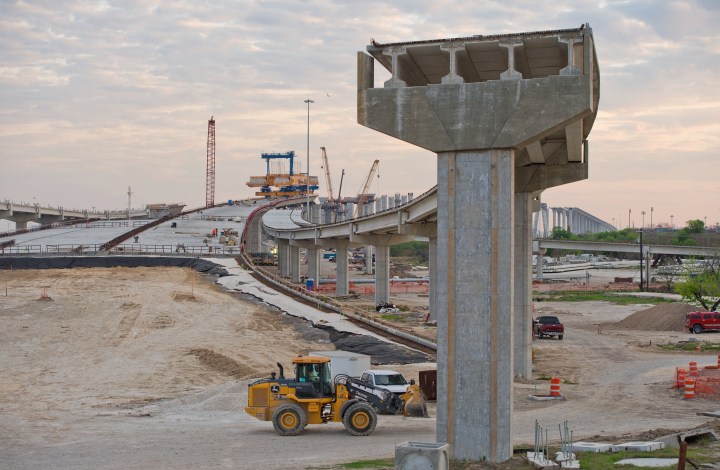SPONSORED CONTENT
Infrastructure as an engine of economic growth

A key reason for this academic focus is to determine the influence of infrastructure on income inequality, poverty, and unemployment, given their importance in a human context.
The role of infrastructure in the developmental narrative has received a significant amount of attention over the last 40 years, with the macroeconomic effects of infrastructure the predominant area of research. A key reason for this academic focus, is to determine the influence of infrastructure on income inequality, poverty, and unemployment, given their importance in a human context.
Starting Point – The Definitions
Economic growth refers to the “increase in output (GDP or GNP) or incomes over a period of time”. When considering the growth narrative, the key consideration is the “removal of barriers to economic efficiency” and there are three static engines of growth:
- Putting idle resources to work – growth is curtailed by idle resources.
- Allocative efficiency – welfare can be raised by allocating resources to produce what people wish to consume.
- Comparative advantage – countries should produce what they are good at.
What does the literature say?
Considering the above, infrastructure development is essential in removing barriers to economic efficiency – a reality that comes through in a host of literature on the topic. Infrastructure development is fundamental for economic growth and poverty reduction, as the availability of this infrastructure (or lack thereof!) influences production costs, employment creation, access to markets, and ultimately investment flows.
Based on the surveyed literature on the topic, a consensus view has emerged: constraints on economic growth and poverty reduction in the African context are due to a lack of adequate infrastructure, with specific reference to transport and logistics, water and sanitation, energy, along with Information and Communication Technology (ICT) and communication networks. Not only does the lack of these types of infrastructure impact the lives of the majority of Africans, but it also negatively impacts the competitiveness of businesses.
Taking this a step further, the literature on growth shows that there is a significant link between the growth rate of an economy and the living standards of the populous in the long run. Simply put, the living standards of a country can be seen as being dependent on its ability to produce goods and services (i.e. productivity), with productivity determined in reference to the various factors of production (i.e. physical capital, human capital, natural resources and technological knowledge). The infrastructure ecosystem thus has a pivotal role to play.
Why invest in infrastructure?
Infrastructure assets, as defined, are long-term real assets that have positive social and environmental impacts. Further to this, these assets have shown to be uncorrelated with general market assets, and have inflation-beating potential. As we have highlighted in the past, these are attractive characteristics for pension fund investors, and to investors with a longer-term horizon.
Importantly, however, when considering the economics of infrastructure assets, our lived experience is that these investments exhibit a lower risk profile than traditional asset classes including bonds, while presenting very attractive real returns. We have thus asked ourselves what the infrastructure risk/return equation currently looks like more broadly.
As noted by Moody’s in their March 2022 report titled “Default and recovery rates for project finance loans”, credit performance in emerging markets and developing countries “remains resilient”. This report puts cumulative default rates at 8.4% to 8.9%, with average recovery rates at 79.2%. Bringing this closer to home, as per the Moody’s default definition, they note that for Africa, the average default is at 5%, which in our view compares favourably with the global average at 4.6%, especially considering the varying economic conditions.
If you then consider the return profile for African infrastructure opportunities, both senior and subordinated/mezzanine debt offers attractive compensation relative to the risk embedded in these assets, as highlighted by the African default experience.
Where do we stand as an industry?
As taken from The Association for Savings and Investment South Africa (ASISA) 2020 survey:
- Total assets under management (AUM) are reported to be R4.4 trillion.
- Exposure to unlisted infrastructure was R102 billion (i.e. 2.3% of AUM).
- Exposure to listed infrastructure bonds was R176 billion (or 4.0% of AUM).
As noted in the above, the total exposure by the ASISA membership to infrastructure equates roughly to 6.3%. We believe that this is a paltry amount when compared to regulatory limits, in terms of prudency and also in relation to the significant infrastructure spend required.
In noting the risk/return paradigm, and importantly the positive impact investing in infrastructure delivers more broadly in the economy, we do believe that under the right conditions, there is a significant quantum of capital available to fund infrastructure investments.
Lastly – What is needed?
While research into the topic continues, a consensus has emerged that under the right conditions, infrastructure investment can play a meaningful role in promoting growth and development; and has the ability to help reduce poverty.
However, infrastructure can only work if supported by the right policies that encourage investment (both local and foreign) into productive sectors of the economy. Further to this, we continue to stand firm in our investment requirements: there needs to be a credible and bankable infrastructure pipeline, an appropriate allocation of risk, regulatory oversight, and most importantly, certainty for investors. DM/BM
Author: Conway Williams – Head of Credit at Prescient Investment Management

Disclaimer:
- Prescient Investment Management (Pty) Ltd is an authorised financial services provider (FSP 612).
- The value of investments may go up as well as down, and past performance is not necessarily a guide to future performance.
- There are risks involved in buying or selling a financial product.
- This document is for information purposes only and does not constitute or form part of any offer to issue or sell or any solicitation of any offer to subscribe for or purchase any particular investments. Opinions expressed in this document may be changed without notice at any time after publication. We therefore disclaim any liability for any loss, liability, damage (whether direct or consequential) or expense of any nature whatsoever which may be suffered as a result of or which may be attributable directly or indirectly to the use of or reliance upon the information.

















 Become an Insider
Become an Insider
Comments - Please login in order to comment.